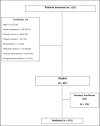Predictors of subclinical carotid atherosclerosis in middle-aged women
- PMID: 29791465
- PMCID: PMC5965873
- DOI: 10.1371/journal.pone.0197582
Predictors of subclinical carotid atherosclerosis in middle-aged women
Abstract
Background: Traditional strategies for primary cardiovascular prevention have been insufficient in reducing the high rates of coronary ischemic events in women, probably because these women are often stratified into low-risk groups. However, cardiovascular diseases continue to be the main cause of morbidity and mortality in women worldwide. We hypothesized that carotid atherosclerosis (CA) is common in middle-aged women.
Methods: We prospectively evaluated asymptomatic peri- and post-menopausal women with no cardiovascular diseases or the use of hormone therapy from two gynecologic clinics. All the patients underwent full clinical and laboratory evaluation and underwent a B-mode ultrasound for carotid evaluations. The presence of CA was defined as the presence of plaque and/or carotid intima-media thickness (CIMT)>1.00 mm. We performed logistic regression to evaluate independent predictors of CA.
Results: We studied 823 women (age: 54.4±5.4 years; body mass index-BMI: 28.5±4.9 kg/m2; diabetes:10%; hypertension: 58%). The prevalence of CA was 12.7% for the entire population and 11% for the low-risk sub-group as defined by a Framingham risk score <5%. In the multivariate model, age: odds ratio (OR) = 1.54, 95% confidence interval (CI) = 1.25-1.89,p<0.001; current smoker status: OR = 2.69, 95% CI = 1.48-4.91, p = 0.001; total cholesterol: OR = 1.13, 95% CI = 1.03-1.24, p = 0.008; and systolic blood pressure: OR = 1.01, 95% CI = 1.00-1.02, p = 0.030 remained independently associated with CA.
Conclusion: Subclinical CA is common among asymptomatic middle-aged women, and traditional risk factors are independently associated with CA. These findings are particularly relevant for improving cardiovascular health in women.
Conflict of interest statement
The authors have declared that no competing interests exist.
Figures
References
-
- Maas AH, van der Schouw YT, Regitz-Zagrosek V, Swahn E, Appelman YE, Pasterkamp G, et al. Red alert for women's heart: the urgent need for more research and knowledge on cardiovascular disease in women: proceedings of the workshop held in Brussels on gender differences in cardiovascular disease, 29 September 2010. Eur Heart J. 2011;32: 1362–1368. doi: 10.1093/eurheartj/ehr048 - DOI - PubMed
-
- Roger VL, Go AS, Lloyd-Jones DM, Adams RJ, Berry JD, Brown TM, et al. Heart disease and stroke statistics—2011 update: a report from the American Heart Association. Circulation. 2011;123: e18–e209. doi: 10.1161/CIR.0b013e3182009701 - DOI - PMC - PubMed
-
- The ACCESS Investigators. Management of acute coronary syndromes in developing countries: acute coronary events-a multinational survey of current management strategies. Am Heart J. 2011;162: 852–859 e822. doi: 10.1016/j.ahj.2011.07.029 - DOI - PubMed
-
- Mosca L, Benjamin EJ, Berra K, Bezanson JL, Dolor RJ, Lloyd-Jones DM, et al. Effectiveness-based guidelines for the prevention of cardiovascular disease in women—2011 update: a guideline from the american heart association. Circulation. 2011;123: 1243–1262. doi: 10.1161/CIR.0b013e31820faaf8 - DOI - PMC - PubMed
-
- Shaw LJ, Bairey Merz CN, Pepine CJ, Reis SE, Bittner V, Kelsey SF, et al. Insights from the NHLBI-Sponsored Women's Ischemia Syndrome Evaluation (WISE) Study: Part I: gender differences in traditional and novel risk factors, symptom evaluation, and gender-optimized diagnostic strategies. J Am Coll Cardiol. 2006;47: S4–S20. doi: 10.1016/j.jacc.2005.01.072 - DOI - PubMed
Publication types
MeSH terms
LinkOut - more resources
Full Text Sources
Other Literature Sources
Medical


